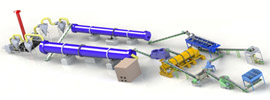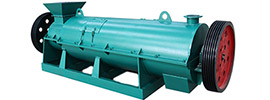Organic fertilizers are showing a positive development trend in the Southeast Asian market, with significant growth potential and development space. The following is a detailed analysis from the aspects of market driving factors, market size and growth, challenges faced, and segmented market conditions:
Market Driving Factors
Rising Environmental Awareness: Governments and the public in Southeast Asian countries are attaching increasing importance to environmental protection. The excessive use of traditional chemical fertilizers can lead to problems such as soil compaction, water pollution, and increased greenhouse gas emissions. Organic fertilizers, as an environmentally friendly and sustainable fertilizer, can improve soil quality and reduce environmental pollution, which is in line with the development trend of green agriculture. Therefore, they are receiving more and more attention and promotion.
Demand for Agricultural Sustainable Development: Southeast Asia is an important agricultural production region, with a leading global output of agricultural products such as rice, palm oil, rubber, and tropical fruits. However, the long - term reliance on chemical fertilizers and pesticides in agricultural production has led to issues such as declining soil fertility and increased pest resistance. Organic fertilizers, rich in organic matter and various nutrient elements, can enhance soil's water and fertilizer retention capacity, increase soil microbial activity, and promote the healthy growth of crops, contributing to the realization of agricultural sustainable development.
Policy Support: To promote the green transformation of agriculture and environmental protection, governments of Southeast Asian countries have introduced relevant policies to encourage the use of organic fertilizers. For example, the Thai government has formulated an organic agriculture development plan, providing subsidies and preferential policies for farmers who use organic fertilizers. The Indonesian government has also increased its support for the organic fertilizer industry to promote the production and application of organic fertilizers.
Changes in Consumer Demand: With the improvement of living standards, consumers in Southeast Asia have higher requirements for the quality and safety of agricultural products. Organic agricultural products are favored by consumers due to their pollution - free and nutrient - rich characteristics, and their market prices are relatively high. This has prompted farmers to increase the use of organic fertilizers to improve the quality and yield of agricultural products and meet market demand.
Market Size and Growth
Current Size: According to data from market research institutions, the market size of organic fertilizers in Southeast Asia has been growing continuously in recent years. Among them, Indonesia, Thailand, and Vietnam are the major consumer markets.
Growth Trend: It is expected that the organic fertilizer market in Southeast Asia will maintain a relatively high growth rate in the next few years. On the one hand, with the acceleration of agricultural modernization and the continuous strengthening of environmental protection policies, the penetration rate of organic fertilizers will further increase. On the other hand, the growing demand from consumers for organic agricultural products will drive farmers to increase their investment in organic fertilizers.
Challenges Faced
Lack of Price Competitiveness: Compared with chemical fertilizers, the production cost of organic fertilizers is higher, and their prices are relatively more expensive. This makes some small - scale farmers more inclined to use lower - priced chemical fertilizers when weighing economic interests. Therefore, improving the production efficiency and reducing the cost of organic fertilizers are the keys to expanding market share.
Difficulties in Technology Promotion: Some farmers lack sufficient knowledge and technical skills regarding the use of organic fertilizers and are short of scientific fertilization methods and experience. In addition, the effects of organic fertilizers are relatively slower compared to those of chemical fertilizers and take a certain amount of time to manifest, which also leads some farmers to have doubts about their efficacy. Therefore, strengthening the promotion and training of organic fertilizer technologies and enhancing farmers' awareness and usage levels are important tasks for promoting market development.
Inconsistent Quality Standards: Currently, the organic fertilizer market in Southeast Asia lacks a unified quality standard and regulatory system, resulting in inconsistent product quality in the market. Some low - quality organic fertilizers not only fail to achieve their intended effects but may also cause damage to soil and crops, affecting consumers' trust in organic fertilizers.
Segmented Market Conditions
Product Types
- Animal - Based Organic Fertilizers: Such as organic fertilizers made from fermented livestock and poultry manure, animal remains, etc. These fertilizers are rich in nutrient elements such as nitrogen, phosphorus, and potassium, have relatively high fertilizer efficiency, and occupy a large market share in Southeast Asia. For example, in Thailand, many large - scale farms process livestock and poultry manure through harmless treatment to produce organic fertilizers, which are then supplied to surrounding farmers.
- Plant - Based Organic Fertilizers: Made from raw materials such as crop straws, green manures, and cake fertilizers, these organic fertilizers have the functions of improving soil structure and increasing soil organic matter. They are welcomed by farmers who focus on soil health and sustainable development. In Vietnam, the practice of returning rice straws to the fields and combining green manure cultivation with the use of organic fertilizers is gradually being promoted.
- Microbial Organic Fertilizers: These are organic fertilizers containing beneficial microbial flora, which can promote the reproduction and activity of soil microorganisms and improve soil fertility. With the development of biotechnology, microbial organic fertilizers have broad application prospects in the Southeast Asian market, especially in high - end agriculture and facility agriculture.
Application Fields
- Rice Cultivation: Southeast Asia is a major rice - producing region in the world, and rice cultivation has a large demand for fertilizers. The application of organic fertilizers in rice cultivation can improve soil fertility, enhance rice's stress resistance, and reduce the occurrence of pests and diseases. For example, in some rice - growing areas in Indonesia, farmers adopt the method of combining organic fertilizers with chemical fertilizers, which not only ensures rice yield but also improves soil quality.
- Fruit Cultivation: Southeast Asia is abundant in tropical fruits such as durian, mangosteen, and mango. The use of organic fertilizers can improve the quality and taste of fruits, increase the sugar content and vitamin content of the fruits, and meet consumers' demands for high - quality fruits. In Malaysia, some durian plantations that use organic fertilizers have higher market prices for their durians, which are more favored by consumers.
- Vegetable Cultivation: With the acceleration of urbanization, the demand for vegetables in Southeast Asia has been increasing. Organic vegetables are popular among consumers due to their safety and health characteristics, driving the application of organic fertilizers in vegetable cultivation. In Thailand, some vegetable cultivation bases that use organic fertilizers mainly supply vegetables to high - end supermarkets and restaurants.
 Send us a Email
Send us a Email Wulong Industrial Cluster
Wulong Industrial Cluster Have any question?
Have any question?


















